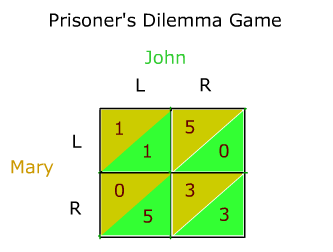Tit for tat, as discussed here, is a strategy used for zero-sum games, such as the Prisoner's Dilemma, in game theory. For those who do not know what the Prisoner's Dilemma is, here is a brief explanation:

Pictured above is a payoff matrix for the prisoner's dilemma. This particular matrix names the participants John and Mary. The game goes as follows, both John and Mary, who have committed a crime and have been arrested by the police, are given a choice. They can either, remain silent or tell the police that the other person committed the crime. If one player remains silent, while the other blames then the one who remained silent will face five years in jail. If both players blame the each other, then they are each given a three year sentence. And lastly, if both players remain silent, they are both sentenced to only one month in jail. The chart above can be read quite easily if it is understood that 'L' means to remain silent (or cooperate), and 'R' means to blame the other (or defect).
Though the Prisoner's Dilemma is often only played one time, it is possible to adapt it so that there are multiple trials. In Professor Maynard's Psychology 272 class such a game was played. In groups of two, players employed various strategies in a ten round zero sum game. Of these strategies was tit for tat, a strategy which starts with the player cooperating with the opponent, and then following the opponent's lead (if the opponent defects, then the player defects. If they cooperate, then the player cooperates). After, the results of the games were tallied. They showed that tit for tat seemed to generate the highest combined score in the class. But the question is: do these statistics indicate that tit for tat is a good behavioral strategy? More specifically, if both players play their strategy perfectly does tit for tat really win most of the time?
Most people will answer that tit for tat is a viable strategy, however let us examine several different scenarios. Terms to know: Cooperative - a strategy that for the most part entails cooperating with the opponent, and defecting seldom. Defective - a strategy that, for the most part, entails defecting with little cooperation.
1. Tit for tat versus Cooperative: If both players execute their strategies correctly, the game should result in the positive payoff for both players. Meaning both players cooperate at every turn. However, it is actually possible for the cooperative player to get a higher score than the tit for tat player, if at the last turn the cooperative player defects. If this happens, then the Tit for tat player, who by his own strategy is forced to cooperate, will have a lower score. Thus, in a two player zero-sum game it seems that cooperative strategy works well against tit for tat.
2. Tit for tat versus Defective: If both players execute their strategies correctly in this case, the game should result in the defective player always having a higher score than the Tit for tat player. This occurs because the Tit for tat player will always start as cooperative, and so the defective player's defect in the very first round of the game will give him the advantage. Following the first round both players should proceed to defect for the remainder of the game. This will always result in the defective player's victory over the tit for tat player. Even if the defective player does not defect on the very first term, he only needs to make sure that once he defects that he continues to defect. This will ensure a higher score than the Tit for tat player.
3. Tit for tat versus tit for tat: If both players execute their strategy correctly in this case, the game should result in both having the same score. The two players will merely cooperate until the game has ended.
In exploring the way tit for tat works against itself and two basic strategies of game theory, it is still hard to understand why tit for tat is considered a good strategy. Richard Dawkins discusses its merits:
Tit for tat excels in the long run, despite the fact that it can never actually get a higher score against a single opponent. Games that involve tit for tat, on average generate higher scores which, in the long run, make tit for tat seem like the most viable strategy.
Practically speaking, tit for tat is a good strategy to employ if a person is willing to take a backseat to their fellow player. In the long run the tit for tat player will benefit the most, but in each isolated incident the tit for tat player will not seem to come out on top. These results express that in most job situations, where employees are competing for a raise, it is more likely that a worker who uses a tit for tat strategy while working with fellow co-workers will have a far more impressive work history than those who are more ego-minded. Tit for tat excels when it meets other cooperative strategies, but is not so agreeable that it is taken advantage of by defective ones.

No comments:
Post a Comment